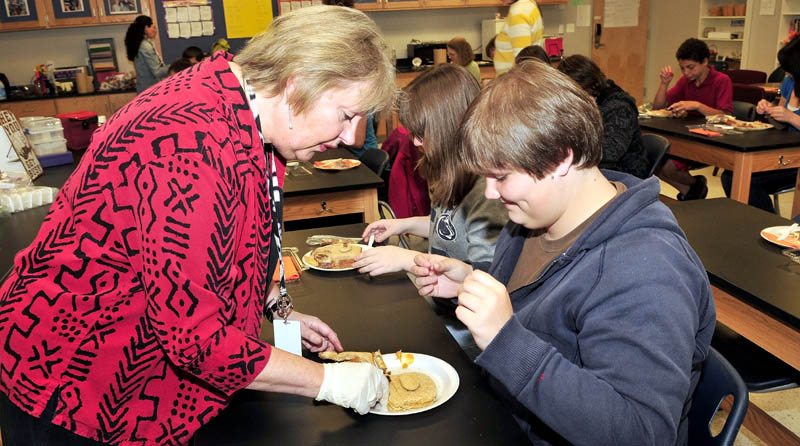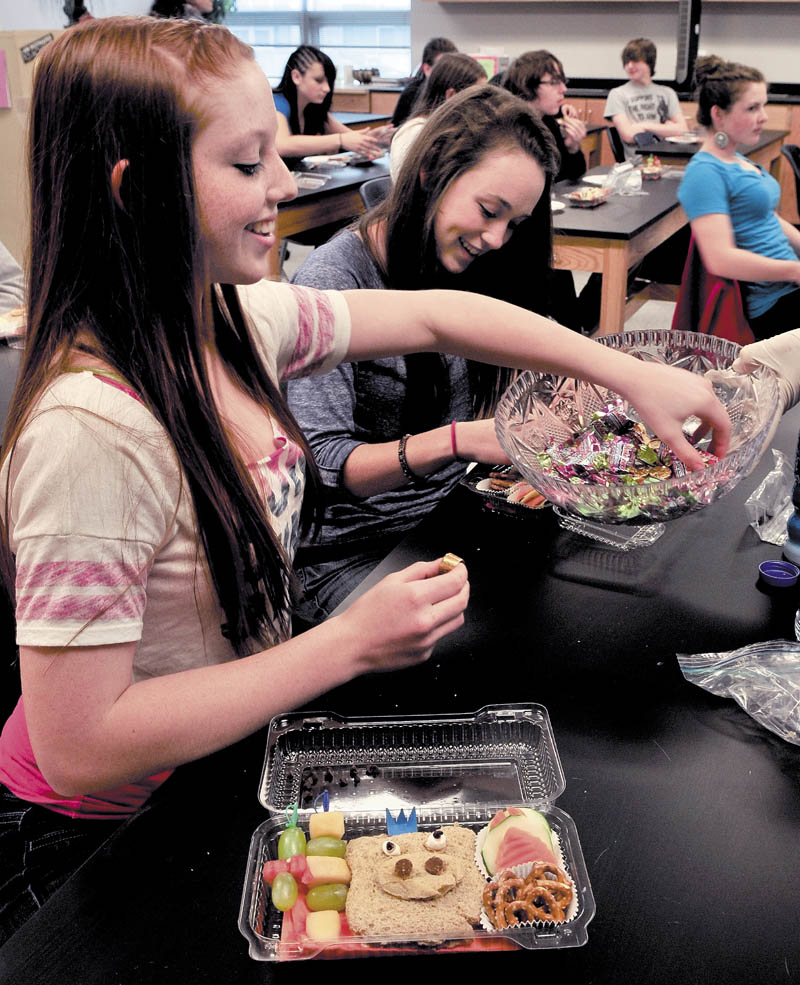WATERVILLE — Karlie Nabarowsky created a small box lunch that was not only healthful, but also beautiful.
It included a peanut butter and jelly sandwich on wheat bread fashioned in the face of a pig and complete with tiny marshmallow eyes and breaded snout; cucumber and carrot slices; tiny wedges of cantaloupe, watermelon and grapes; and five curly pretzels.
Nabarowsky, 15, was one of 17 Waterville Senior High School students in Christine Rasmussen’s workshop Wednesday learning how to devise Japanese-style Bento lunches as part of Disease & Health Day at the school.
More than 500 students spent the morning attending workshops on everything from healthful eating to careers available in the health care field.
Rasmussen told students that Bento is a Japanese word for “lunch in a box.”
One can devise and pack an elaborate or simple, yet practical and healthful lunch every day in a reusable box, she said. The lunch can be artistic, creative and pleasing to the eye.
The portion-controlled meal is typically one part protein, three parts carbohydrate such a bread or rice, and two parts fruit and vegetable.
“It makes me very happy when I open it up and see what I’ve made,” said Rasmussen, a special education teacher who brings Bento lunches to school herself.
“This is less than 600 calories, and look at all the variety, so for adults, it’s great,” she said.
Nabarowsky, a freshman, said she enjoyed building the Bento lunch and plans to do it at home with her little brothers.
“It’s actually really cool,” she said. “It’s healthy. You have different food groups and everything and it’s fun to make.”
Tiffani Melia, 14 and also a freshman, echoed Nabarowsky’s sentiments.
“It’s really fun,” she said. “I have diabetes, so I know it’s actually a pretty healthy lunch.”
Alan Haley, chairman of the social studies department, headed up the Disease & Health Day program. He said his department several years ago started discussing disease in modern history as a major factor in shaping the world, and students took part in a smaller version of the program. This is the first year the event involved the whole school, Haley said.
Presenters Wednesday taught yoga, explained what HealthReach Hospice is and does, gave a lesson in what happens after a person calls 911 and emergency crews spring into action, and taught students about diseases that affect us and our pets.
Mental health, physical activity, health systems around the world and the impact of media on nutrition and physical activity for young adults also were topics.
Haley said students were excited about the event.
“We had a number of kids looking forward to coming to school today just to do this,” he said.
Principal Don Reiter said students were intrigued.
“Alan’s (Haley) done a great job taking this on,” Reiter said. “It’s something he’s been trying to get done for a couple of years.”
Senior Jeremy Nguyen, 19, said he enjoyed listening to a presentation by physician Dmitry Opolinsky, a nephrologist from MaineGeneral Medical Center, who spoke to the entire school about preventative health.
Nguyen said it’s not easy for someone to capture his attention, but Opolinsky drew him in with his discussions about poverty and how it can lead to obesity.
“He was someone we can listen to, pay attention to,” Nguyen said.
Opolinsky said he is a kidney doctor who works with people who are quite sick.
“Any doctor will tell you we see so much sickness that could have been prevented, that it will make us think about public health even when we are not doing public health work,” he said.
Wellness, he said, is not something we can buy — we have to work on it. He described wellness as being in good health and feeling well.
Fifty percent of health and wellness is determined by lifestyle choices; heredity, which is difficult to change, is 20 percent; environment, 20 percent and medical care, 10 percent, he said.
Mental health also is important, he said.
“How you think will determine how you feel, and how you think and how you act will physically change your brain.”
Obesity is a great threat; it is a cultural, financial and medical challenge, according to Opolinsky.
“Two-thirds of people in our society today in the U.S., in Maine, are not normal. They have a weight that’s going to make them sick.”
He said people who are chronically sick in the U.S. become poor, and poor people can become sick.
“My best recommendation to you is, don’t be poor — go to college,” he said.
Amy Calder — 861-9247
acalder@centralmaine.com
Send questions/comments to the editors.





Success. Please wait for the page to reload. If the page does not reload within 5 seconds, please refresh the page.
Enter your email and password to access comments.
Hi, to comment on stories you must . This profile is in addition to your subscription and website login.
Already have a commenting profile? .
Invalid username/password.
Please check your email to confirm and complete your registration.
Only subscribers are eligible to post comments. Please subscribe or login first for digital access. Here’s why.
Use the form below to reset your password. When you've submitted your account email, we will send an email with a reset code.